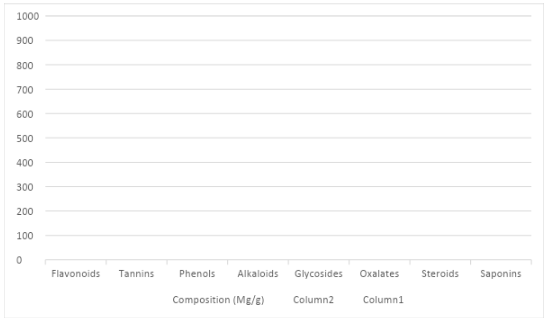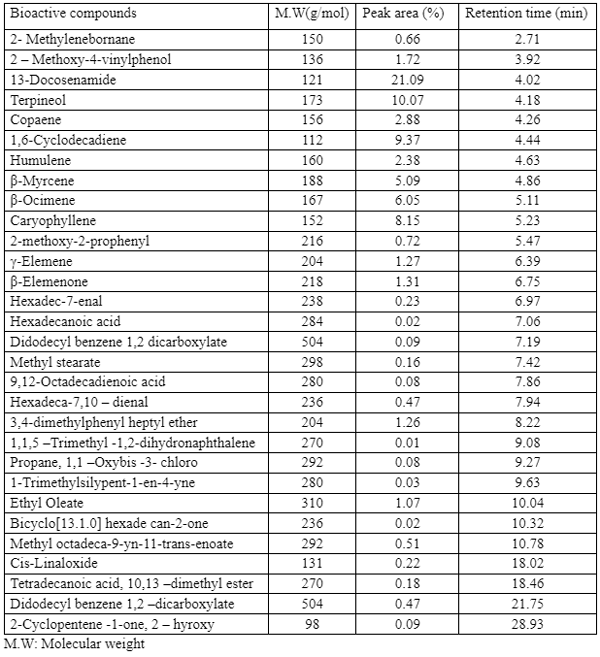Analysis of bioactive compounds
This study investigated the bioactive compounds in ethanolic extract ofXylopia aethiopicaleaves using gas chromatography and mass spectrometry (GC-MS) technique. The phytoconstituents present in Xylopia aethiopicaleaves were: flavonoids (951.82 mg/g), tannins (282.70 mg/g), alkaloids (188.47 mg/g), phenols (603.25 mg/g), saponins (11.47 mg/g), steroids (91.20 mg/g), oxalates (190.32 mg/g) and glycosides (190.32 mg/g). A total number of 30 bioactive compounds were identified based on their peak areas. The major compounds greater than 1 % were; 13-docosenamide (21.09 %), terpineol (10.07 %), 1,6-cyclodecadiene (9.37 %), copaene (2.88 %), caryophyllene (8.15 %), β-ocimene (6.05 %), β-myrcene (5.09 %), copaene (2.38 %), 2 – methoxy-4-vinylphenol (1.72 %), β-elemenone (1.31 %), 3,4-dimethylphenyl heptyl ether (1.26 %), ethyl oleate (1.07 %) and γ-elemene (1.27 %) while those less than 1 % (˂ 1 %) were; 2- methylenebornane (0.66 %), 2-methoxy-2-prophenyl (0.72 %), hexadec-7-enal (0.23 %), hexadecanoic acid (0.02 %), didodecyl benzene 1,2 dicarboxylate (0.09 %), methyl stearate (0.16 %), 9,12-octadecadienoic acid (0.08 %), hexadeca-7,10 – dienal (0.47 %), 1,1,5 –trimethyl -1,2-dihydronaphthalene (0.01 %), propane, 1,1 – oxybis -3- chloro (0.08 %), 1-trimethylsilypent-1-en-4-yne (0.03 %), bicyclo[13.1.0] hexade can-2-one (0.02 %), methyl octadeca-9-yn-11-trans-enoate (0.51 %), cis-linaloxide (0.22 %), tetradecanoic acid, 10,13 –dimethyl ester (0.18 %), didodecyl benzene 1,2 –dicarboxylate (0.47 %) and 2-cyclopentene -1-one, 2 – hyroxy (0.09 %). However, all the compounds have a wide range of pharmacological activities including- antimicrobial, antioxidant, anti-malarial, antifungal, anti-arrhythmic, anti-viral, hepato-protective, anti-proliferative, anti-depressant, antipyretic and antihelminthic.
Keywords: Xylopia aethiopica, anti-microbial, phytochemicals, gas chromatography, mass spectrometry, free radicals.
Introduction
Materials and methods
Experimental site
Collection, authentication and processing of Xylopia aethiopica leaf extract
Quantitative determination of phytochemical components
Analysis of bioactive compounds of Xylopia aethiopica leaves using GC-MS technique
Results and discussion
Phyto-constituents of Xylopia aethiopica leaf extract


Bioactive compounds of Xylopia aethiopica leaf extracts by Gas chromatography and mass spectrometry technique
Conclusion

Muritala, Daniel Shittu., Alagbe, J.O., Ojebiyi, O.O., Ojediran, T.K and Rafiu, T.A. (2022). Growth performance and haematological and serum biochemical parameters of broiler chickens given varied concentrations of Polyalthia longifolia leaf extract in place of conventional antibiotics. Animal Science and Genetics 18(2): 57-71.
Nikal (2020). Role of medicinal plants and aromatic plants in National economy and export potentials. Pharmacognosy Subject in Diploma in Pharmacy.
Adel-Rahman and Adel-Ghaffar (2020). Neutraceuticals – Lecture 5 – Phytochemicals.
Sushila, S. (2017). Medicinal plants seminar presented at Department of Chemistry Deshbandhu College, University of Delhi, India (2017).
Paula, D., Anna, P., Magdalena, N., Natalia T (2018) The use of azelaic acid in selected dermatological disorders. Med Rodz 21(4):307–314
Alagbe, J.O., Bamigboye, S., Nwosu, G.C., Agbonika, D.A and Kadiri Mercy Cincinsoko. (2023). Characterization of bioactive compounds in Luffa aegyptiaca leaf ethanolic extracts using gas chromatography and mass spectrometry (GC-MS). Drug Discovery, 2023; 17:e10dd1011.
Adeniyi, S.A., Orjiekwe, C.L, Ehiagbonare, J.E. (2009). Determination of alkaloids and oxalates in some selected food samples in Nigeria. African Journal Biotechnology, 8(1): 110-112.
Madhu M, Sailaja V, Satyadev TNVSS. (2016). Quantitative phytochemical analysis of selected medicinal plant species by using various organic solvents. Journal of Pharmacogsy Phytochemical, 5(2): 25-29.
Hoet, S., Pieters, L., Muccioli, G.G., Habib-Jiwan, J., Opperdoes, F.R, Quetin- Leclercq, J. (2007) Antitrypanosomal activity of triterpenoids and sterols from the leaves of Strychnos spinosa and related compounds. Journal of National Production, 70:1360–1363
Otles, S and Yalcin, B. (2012). Phenolic compounds analysis of root, stalk, and leaves of Nettle. Science World Journal. 2012: 564367. DOI: 10.1100/2012/564367.
Agubosi, O.C.P., Alexander, James and Alagbe, J.O. (2022). Influence of dietary inclusion of Sunflower (Helianthus annus) oil on growth performance and oxidative status of broiler chicks. Central Asian Journal of Medical and Natural Sciences 2(7): 187-195.
Sarker SD, Nahar L. (2007). Chemistry for Pharmacy Students General, Organic and Natural Product Chemistry. Indian Journal of Physiology and Pharmacology, 2007; 283-359.
Agubosi, O.C.P., Soliu, M.B and Alagbe, J.O. (2022). Effect of dietary inclusion levels of Moringa oleifera oil on the growth performance and nutrient retention of broiler starter chicks. Central Asian Journal of Theoretical and Applied Sciences 3(3): 30-39.
Alagbe John Olujimi, Ramalan Sadiq Muhammad., Shittu Muritala Daniel and Olagoke Olayemi Christiana (2022). Effect of Trichilia monadelpha stem bark extract on the fatty acid composition of rabbit’s thigh meat. Journal of Environmental Issues and Climate Change 1(1): 63-71.
Saxena M, Saxena J, Nema R, Singh D, Gupta, A. (2013). Phytochemistry of Medicinal Plants. Journal of Pharmacognosy and Phytochemistry Center for Microbiology and Bio-Technology Research and Training, Bhopal, India, 8192 (1): 168-182
Alagbe, J.O. (2023). Bioactive compounds in ethanolic extract of Strychnos innocua root using gas chromatography and mass spectrometry (GC-MS). Drug Discovery, 2023; 17:e4dd1005.
Alagbe, J.O., Adeoye, Adekemi and Oluwatobi, O.A. (2020). Proximate and mineral analysis of Delonix regia leaves and roots. International Journal on Integrated Education. 3(10): 144-149.
Singh Sharma., Alagbe Olujimi John., Liu Xing., Sharma Ram and Kumar Amita (2022). Comparative analysis of ethanolic Juniperus thurifera leaf, stem bark and root extract using gas chromatography and mass spectroemetry. International Journal of Agriculture and Animal Production, 2(6): 18-27.
Adams, D., Midel, M.J., Dastgir, J., Flora, C, Molinari, R.J, Heerinckx, F., Endemann, S., Atwal P, Milner, P and Shchpinor, M.S. (2020) Treatment of infantile neuroaxonal dystrophy with RT001: a di-deuterated ethyl ester of linoleic acid: report of two cases. JIMD Rep 54(1):54–60
Alagbe, J.O., Adedeji, M.O., Habiba, Z., Nwosu, Gloria and Wyedia Dabara Comfort (2021). Physico-chemical properties of Indigofera zollingineriana seed oil. Asian Journal of Advances in Medical Science 3(4): 306-308.
Singh, G., Kapoor, I.P.S., Singh, P, Carola, S. (2010) Comparative study of chemical composition and antioxidant activity of fresh and dry rhizomes of turmeric (Curcuma longa Linn.). Food Chemistry and Toxicology, 48(4):1026–1031.
Agubosi, O.C.P., Oluwafemi, R.A., andAlagbe, J.O.(2021). Preliminary study on GC-MS analysis of Prosopis africana seed (African mesquite) oil. Journal of Ethics and Diversity in International Communication 1(4): 18-20.
Hongxiang, S., Cuirong, S and Yuanjian, P. (2005) Cytotoxic activity and constituents of the volatile oil from the roots of Patrinia scabra Bunge. Chemical Biodiversity, 2(10):1351–1357
Alagbe, J.O., Shittu, M.D and Ushie, F.T. (2021). GC-MS analysis of methanolic stem bark extract of Zollingeriana indigofera. Asian Journal of Advances in Research 11(4): 144-146.
Musa, B.,Alagbe, J.O.,Adegbite Motunrade Betty, Omokore, E.A. (2020).Growth performance, caeca microbial population and immune response of broiler chicks fed aqueous extract of Balanites aegyptiaca and Alchornea cordifolia stem bark mixture. United Journal for Research and Technology, 2(2):13-21.
Oluwafemi, R.A., Isiaka Olawale and Alagbe, J.O. (2020). Recent trends in the utilization of medicinal plants as growth promoters in poultry nutrition- A review. Research in: Agricultural and Veterinary Sciences. 4(1): 5-11.
Alagbe, J.O (2019). Proximate, mineral and phytochemical analysis of Piliostigma thonningii stems bark and roots. International Journal of Biological, Physical and Chemical Studies, 1(1): 1-7.
Sczkowski CP, Kalinowska M, Wojciechowski Z. (1998). The 3-Oglucosylation of steroidal saponins and alkaloids in eggplant (Solanum melongena); evidence for two separate glycosyl transferences, Phytochemistry, 48: 1151-1159.
Stary R.R. (1998).The plant cell wall as a source of dietary fiber: chemistry and structure. American Journal of Clinical Nutrition, 39: 320–337
Alagbe, J.O. (2019). Growth performance and haemato-biochemical parameters of broilers fed different levels of Parkia biglobosa leaf extracts. Academic Journal of Life Sciences. 5(12): 107 – 115.
Okwu, D.E. (2004). Phytochemical and vitamin content of indigenous spices of South Eastern Nigeria. J. Sustain Agric. Environment, 2004; 6:30-37.
Alagbe, J.O. (2017). Nutrient evaluation of sweet orange (Citrus sinensis) fruit peel as a replacement for maize in the diets of weaner grass cutters. Scholarly Journal of Agricultural Science. 6(8):277-282.
Oluwafemi, R.A., Agubosi, O.C.P andAlagbe, J.O. (2021). Proximate, minerals, vitamins and amino acid composition of Prosopis africana (African mesquite) seed oil. Asian Journal of Advances in Research 11(1): 21-27.
Okwu, D.E and Josiah, C. (2006). Evaluation of the chemical composition of two Nigerian medicinal plants. African Journal of Biotechnology, 4: 357-361.
Oluwafemi, R.A., Lawal Aisha Omolade., Adelowo, Samad Adetope and Alagbe, J.O. (2021). Effects of dietary inclusion of ginger (Zingiber officinale) and garlic (Allium sativum) oil on carcass characteristics and sensory evaluation of broiler chicken. Texas Journal of Multidisciplinary Studies, 2(11): 180-188.
Adewale, A.O., Alagbe, J.O., Adeoye, Adekemi. O. (2021). Dietary Supplementation of Rauvolfia Vomitoria Root Extract as A Phytogenic Feed Additive in Growing Rabbit Diets: Haematology and serum biochemical indices. International Journal of Orange Technologies, 3(3): 1-12.
Shittu, M.Dand Alagbe, J.O.(2020). Phyto-nutritional profiles of broom weed (Sida acuta) leaf extract. International Journal of Integrated Education. 3(11): 119-124
Akintayo Balogun Omolere. MandAlagbe, J.O(2020). Probiotics and medicinal plants in poultry nutrition: A review. United International Journal for Research and Technology, 2(1): 7-13.
Alagbe, J.O. (2022). Prosopis africana (African mesquite) oil as an alternative to antibiotic feed additives on broiler chickens diets: performance and nutrient retention. Discovery 58(314): 134 -142.
Alagbe, J.O and Ushie, F.T. (2022). Growth performance of broiler chicks fed diets containing different levels of aqueous Citrus aurantium stem bark extracts. Discovery 58(319): 735-741.
Oyeleke, S.B, Dauda, B.E.N and Boye, O.A. (2008). Antibacterial activity of Ficus capensis. African Journal of Biotechnology, 7(10):1414-1417.
Alagbe, J.O (2020).Chemical evaluation of proximate, vitamin and amino acid profile of leaf, stem bark and roots of Indigofera tinctoria. International Journal on Integrated Education. 3(10): 150-157.
Poumarad, S.J., Hosseinimehr, S.J amd Shababimajd, N. (2006). Antioxidant activity, phenol and flavonoid contents of some selected Iranian medicinal plants. African Journal of Biotechnology, 5(2): 1142-1145.
Alagbe, J.O.,Ajagbe, A.D., Attama Jeremiah, Philemon, K.C and Bello, Kamoru, A (2020). Albizia lebbeck stem bark aqueous extract as alternative to antibiotic feed additives in broiler chicks diets: Haematology, Serum indices and oxidative status. International Journal of Biological, Physical and Chemical Studies, 2(1): 8-15.
Bose Ashish (1991). Demographic diversity of India census state and district level data. B.R. Publication.
Alagbe, J.O (2020). Caecal Microbial Population of Growing Grass Cutters (Thyronoyms Swinderianus) Fed Phyllantus Amarus and Pilogstigma Thonngii Leaf Meal Mixture as Partial Replacement for Soya Bean Meal. Concept of Dairy and Veterinary Sciences. 3(5): 350 – 355.
Tan, A.C., Konczak, I., Sze, D.M. and I. Ramzan. (2010)Towards the discovery of novel phytochemicals for disease prevention from native Australian plants: an ethnobotanical approach. Asian Pacific Journal Clinical Nutrition, 19(3): 330–334.
Akintayo Balogun Omolere. MandAlagbe, J.O(2020). Probiotics and medicinal plants in poultry nutrition: A review. United International Journal for Research and Technology, 2(1): 7-13.
Alagbe, J.O. (2020). Effect of dietary supplementation of Cymbopogon Citratus oil on The Performance and Carcass characteristics of broiler chicks. European Journal of Biotechnology and Bioscience. 8(4): 39-45.
Tapsell, L.C., Hemphill, I., and Cobiac, L., Patch, C.S., Sullivan, D.R., Fenech, M., Roodenrys, S., Keogh, J.B., Clifton, P.M., Williams, P.G., Fazio, V.A. and K.E. Inge. (2006). Health benefits of herbs and spices: the past, the present, the future. Medicinal Journal of Australia, 185(4): S4–24.
Agubosi, O.C.P., Oluwafemi, R.A and Alagbe, J.O. (2021). The effect of processing on the proximate, mineral and vitamin composition of Neem leaves (Azadirachta indica) grown in Gwagwalada, FCT, Abuja. Abuja Journal of Agriculture and Environment, 1(1): 293-299.
Orwa, C., Mutua, A. , Kindt, R. , Jamnadass, R. and Simons, A. (2009). AgroforestreeDatabase:a tree reference and selection guide. Version 4.0 (http://www.worldagroforestry.org/af/treedb/)
Soladoye, M.O., Chukwuma, E.C. and F.P. Owa. 2012. An ‘Avalanche’ of plant species for the traditional cure of diabetes mellitus in South-Western Nigeria. Journal of Natural Product and Plant Resources, 2:60–72
Burkill, H. M (1985). "Entry for Xylopia aethiopica Dunal A. Rich. : family Annonceae". The useful plants of west tropical Africa, Vol 1 (JSTOR). Retrieved 12 March. 2020.
Obodo, B.N., Iweka, F.K., Obhakhan, J.O., Dada, F.L., Festus, O.O. and Onoyovwi, A.O. (2013) Hepatic Potentials of Xylopia aethiopica Leaves in Adult Wistar Rats. International Journal of Herbs and Pharmacological Research, 2, 36-41.
Konan, N.D., Bosson, A.K., Mamyrbekova-Bekro, J.A., Jean, N. and Bekro, Y.A. (2009) Chemical Composition and Antioxidant Activities of Essential Oil of Xylopia aethiopica (Dunal) A. Rich. European Journal of Scientific Research, 2, 311-318.
Kiran, S.R. and Devi, P.S. (2007) Evaluation of Mosquitocidal Activity of Essential Oil and Sesquiterpenes from Leaves of Chloroxylon swietenia DC. Parasitology Research, 101, 413-418
Boampong, J.N., Ameyew, E.O., Aboagye, B., Asare, K., Kyei, S., Donfack, J.H and Woode, E. (2013). The curative and prophylactic effect of Xylopia acid on Plasmodium berghei infection in mice. Journal of Parasitology, 2013: 1-7.
Boyom, F.F., Ngouana, V., Zollo, P.H., Menut, C., Bessiere, J.M., Gut, J., Rosenthal, P.J. (2003). Composition of antiplasmodial activities of essential oils from some Cameroonian medicinal plants. Phytochemistry, 64: 1269-1275.
Germolec, D.R., Kashon, M., Nyska, A., Kuper, C.F., Portier, C., Kommineni, C., Johnson, K.A and Luster, M.I. (2004). The accuracy of extended histopathology to detect immunotoxic chemicals. Toxicological Science, 82: 504-514.
Kuefe, W. (2014). The discovery of Aspirin: A reappraisal. BMJ Clinical Research 321(7276): 1591-1594..







